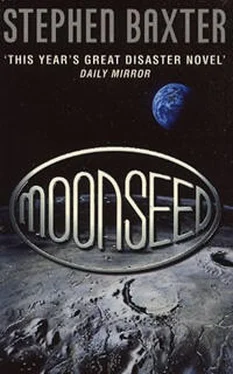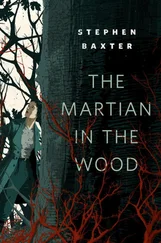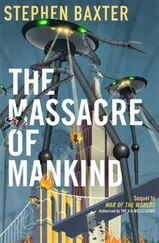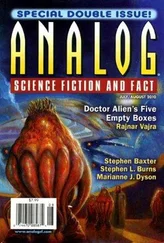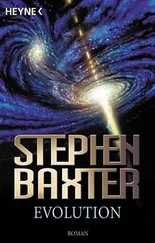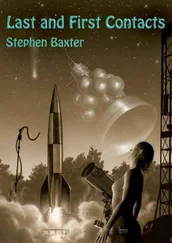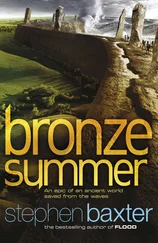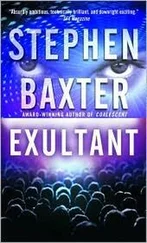But the high-pressure tests weren’t showing them anything they didn’t know already.
“In the meantime, we’re ordering up other studies. X-ray fluorescence work, and time on the ion microprobe they have here. That lets us study the composition of very small samples of the rock…” He scratched his head under his hat. “I’ll tell you something else odd. The samples I’ve been taking from the liquefaction patch, on Arthur’s Seat—”
“I’d like my bottle back sometime.”
“Yeah. I ran them through the “scope, and a couple of other tests. They are deficient in olivine as well…”
She frowned.
“I can’t see any connection either. Spooky coincidence, huh.”
But she was hesitating. As if there was something, some connection, she wasn’t telling him.
He said, “You know, if this — whatever — is consuming olivine—”
“What?”
“The Earth contains a lot of olivine, in the mantle. No wonder that patch is growing. And it isn’t going to stop eating either.”
“Eating?” She laughed, a little nervously. “You make it sound alive.”
“I don’t know what the hell I mean.”
“Do you think we should tell somebody about this?” she asked.
“Like who?”
She shrugged. “The police.”
He blinked. That hadn’t occurred to him, that aspect of the situation. The threat. Maybe Geena was right that he had a one-dimensional mind.
“You know, I don’t like the inexplicable.”
“Oh, come on,” she said. “Be honest with yourself. I know you people. You have a puzzle, and that makes you happy. Something you have to figure out.”
He straightened up. “Buy me lunch and we’ll discuss it.”
She smiled.
“Listen, you want to see 86047 before you go? The bedrock sample. It’s in the case over there by the wall.”
She shrugged. “You’ve seen one Moon rock, you’ve seen them all.”
They made their way to the door, and squeezed into the improvised airlock together.
Behind them, in the central glove box, sample 86047 sat in the lab’s fluorescent light.
It had already been sliced in half and thin samples taken, by Houston technicians and Mike’s careful hands. In the harsh illumination it would have been difficult to tell for sure, but perhaps a careful observer might have noticed something odd about its flat, new surfaces, exposed for the first time since the formation of the rock, billions of years before.
The surfaces were glowing, softly silver.
And, with a rustle rendered inaudible by the layers of glass encasing the rock, a rain of fragments was whispering down from the exposed face.
Jane drove Henry to a multistorey car park close to Waverley Station, and they walked along Princes Street.
You could still make out the deliberate design of the old streets here, Henry thought: a neat rectangular grid pattern, almost like a US city. But whatever character the street had once had was pretty much obscured by the encrustation of plastic and glass of the modern department stores and fast food outlets. There was even a McDonald’s and a Dunkin” Donuts.
“This is what we call the New Town,” Jane said.
“I know. 1760. You told me.”
“The Old Town is the medieval town that grew up around Castle Rock. Narrow, windy streets, coming down the glacial tail there…”
“You’ve been building this city for a thousand years, on top of an extinct volcano. I think you people are seriously crazy.”
“Well, maybe. In the Old Town they burned witches; in the New Town they bred lawyers and scientists.”
“Split personality.”
“Yeah. Jekyll and Hyde.”
“Right. Didn’t Stevenson come from Edinburgh?”
“Yes. Maybe we do have a split personality,” she said. “It was in Edinburgh that the crucial moments in the Act of Union were played out. Union with England.”
“Let me guess. Back in 1672.”
“Actually, 1707. It was the best for everybody. The alternative would have been civil war, or maybe war with England. What we gained was stability and prosperity. But what we lost was something you can’t define. Edinburgh used to be a capital. It never would be again. So, I think we’ve all gone slowly crazy.”
“Conflicts in the programming,” Henry said. “A city called Hal.”
“Something like that.”
“You Brits amaze me. The way you’re so hung up on stuff that happened so long ago.”
“And you guys have no history. History sticks around.”
He glanced around, at Princes Street Gardens, the park which descended in the shadow of Castle Rock. “Was this a river bed?”
“No. But it was a loch. Artificial. Used to dump their sewage in it—”
“And drown witches.”
“Actually, yes. They drained it, to make the New Town.”
“So, lunch…”
It was still early. After a debate they settled on a Seattle’s Best Coffee outlet, which Henry was surprised to find here, and they drank lattes and ate immense chocolate chip cookies.
It was a relief to get in out of the cold.
“Your work seems to be going better,” she said.
“You mean I’m not complaining so much.”
“How come?”
He couldn’t see any way to escape, so he pulled a package from his jacket pocket, and told her the truth.
It was a courier package from Houston. It contained a tape and a transcript of a conversation with Jays Malone, in which the old guy had evidently done his very best to ransack his memories, and provide Henry with the context he needed.
He tried to explain this to Jane. “Geology is about decrypting a tangled story: how a rock was formed, how it got where it was and what happened to it since is as important as what it’s made of. That’s what we call context. And that’s what Jays has given me here.” He scratched his head. “I’m no fan of Man-in-Space. Not when it cuts into good unmanned science missions.”
“Including your own.”
“Yes. But the astronauts weren’t bad geologists, on the whole, when they tried. Pilots are trained to be observers, after all, and they all had strong, flexible minds. I suspect they competed with each other to turn in good performances as scientists.”
Jane leafed through the little package, complete with a few sketch maps and diagrams in Jays’s spidery old man’s hand. There was a brief note in there, which Jane now found.
She eyed Henry. “So who’s Geena?”
He winced. “My ex-wife.”
She nodded, impassive, and handed him the note. “So what is this? Is she building a bridge?”
Henry glanced at the note again. Geena was about to go into purdah, working as a capcom on the current Station mission, and beginning the long process of training for her next flight…
“No,” he said. “Not a bridge. This is Geena waving farewell from the far side of the ravine. Good luck with your life.”
“Sad,” Jane said.
“History.”
“I think I’m starting to understand you,” she said, studying him.
He felt uncomfortable under the scrutiny. “You are?”
“You really are a true scientist. You like figuring out how the world works. You like the fact that it works logically at all. You find that comforting.”
He rubbed his cheek. “I guess that’s true. Take the Moon. The Moon is very different from the Earth, but the basic principles still apply. Like stratigraphy—”
“Like what?”
“On Earth, in general, younger formations lie on top of older formations. Think about the Grand Canyon. A big slice down through millions of years of sedimentary layers, older under younger, older under younger. And it’s the same on the Moon. The big impact that created the Mare Imbrium, for instance, pretty much blanketed the Moon with debris — all of about the same age. So you can tell almost at a glance, anywhere on the Moon, whether a given unit is younger or older than Imbrium. When I learned for the first time that on the Moon, the logic of geology works just the same as in Arizona… well. Isn’t it something?”
Читать дальше
Конец ознакомительного отрывка
Купить книгу
